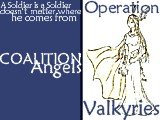« Cheap Labor | Main | Putting Things Into Perspective... »
July 13, 2006
Maritime Coyote Bites The Dust
Even though our own federal Immigration enforcement authorities seem to be having a problem with doing the job we pay them to do, it's great to know that the U.S. Coast Guard is on the ball.
On December 18, 2005 Rivero was seen operating a 33-foot Donzi (go-fast) heading north traveling at 38 knots when he was intercepted by a Coast Guard response boat. The Coast Guard crew energized their blue lights and attempted to communicate with the operator of the speeding go-fast. Rivero failed to stop his boat and on two occasions attempted to ram the Coast Guard boat.The Coast Guard crew used warning shots to persuade Rivero to stop, but he continued operating the boat in a reckless manner. After failing to comply, the Coast Guard boarding team fire disabling fire into the go-fast's engines.
Once on board the stopped go-fast, the boarding team found 10 Cuban migrants in a sealed compartment. Rivero and a second smuggler had placed the migrants in a forward compartment shutting the hatch with a bungee cord from the outside.
In February, After picking up migrants in Cuba, he was chased by a Cuban gun boat when a female from his boat fell over board and drowned. Rivero was again intercepted by the Coast Guard with 21 illegal Cuban migrants on board a 30-foot go-fast 50 miles southeast of Key West, Fla.
Having been convicted, Rivero has been sentenced to 10, count 'em, ten years.
Way to go, Coasties!
Posted by Seth at July 13, 2006 11:03 AM
Comments
Good for the CG. Let's hope they keep catching these thugs and bringing them to justice.
Posted by: Raven at July 13, 2006 03:40 PM
They will, believe it!
Considering their excellent performance in coastal security with the technology of 30 years ago, today it's got to be really intense.
Back then, C.G. 378s (high endurance cutters) on "Ocean Stations" actually kept complete track of inbound ship activity, including the ships' identities, where they came from and for which ports they were supposed to be bound, even to the extent of projecting where ongoing headings would take them, and when, based on their current speeds and so forth, they would get there. Today, there are are likely things like transponder signals and radar linked software doing a lot of that work, leaving the folks on the bridge and in CIC free to deal with less routine matters.
Posted by: Seth at July 13, 2006 04:21 PM







